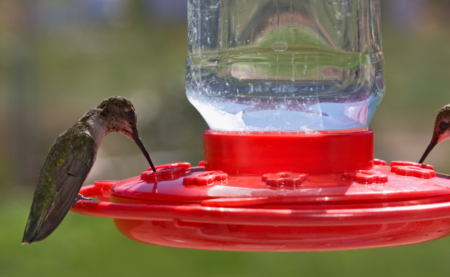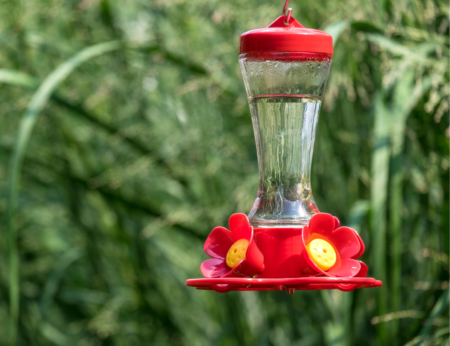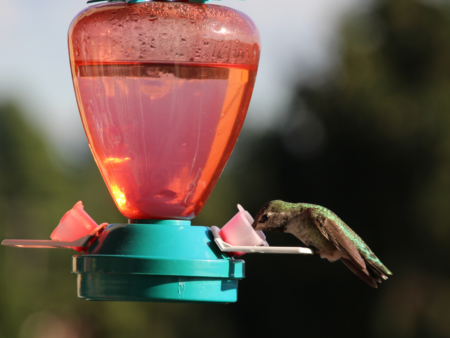If you live in North, Central, or South America, perhaps you’ve had the pleasure of meeting a hummingbird in some outdoor space. These energetic, aggressive, often brilliantly colored birds are a pleasure to watch. Additionally, they’re a welcome sign that winter is over in colder climates. Hummingbirds are a real capstone on any wildlife garden, and you can attract them using native flowers as well as feeders. But what should you put in your feeders? While store-bought nectars might be a convenient option, making your own hummingbird food is super easy. In this Outdoor Tips post, I’ll walk you through the best recipe for homemade hummingbird nectar.
Before we get to the recipe itself, let’s explore what artificial nectar sources like feeders do for hummers.
A High-energy lifestyle

Hummingbirds’ bodies have adapted to an enormously high-energy lifestyle. They move fast, they chase each other around, they flap their wings up to 90 times per second. It’s all gas pedal and no brake with hummingbirds. You can think of them as the polar opposite of sloths, whose bodies run super slow to conserve energy.
By comparison, hummingbirds are absolute gas-hogs! Being so small, they also can’t gorge themselves on massive amounts of heavy food. As a result, they need to feed on nectar every 10-15 minutes. This can mean thousands of visits to different flowers every day!
Extra gas for the tank

In essence, what hummingbird feeders provide is one more easy refueling station to help hummers along. Hummingbirds will supplement their diets with visits to lots of other plants (and you should plant some!), so their lives shouldn’t depend on it.
Keep it simple!

Because you won’t be trying to meet all of their dietary needs, it’s worth keeping your recipe for hummingbird nectar simple. This means one thing, and one thing only: sucrose.
Sucrose is a simple sugar molecule, and the main chemical ingredient in table sugar and candy. This is hummingbirds’ preferred sugar, and they’re capable of digesting it with nearly 100% efficiency.
Although many other sweet things contain sucrose, they may also contain other chemicals. Unfortunately, anything more than just sucrose can be problematic for several reasons:
- These things could attract other wildlife like bees
- They could cause fungal or bacterial growth that puts hummingbirds in danger
- Other ingredients might be harmful or toxic to hummingbirds
This means that the best option for hummingbirds is the simplest possible recipe. Get them some processed table sugar (sucrose) and leave it at that.
What kind of sugar should you give to hummingbirds?

Keeping it as simple as possible is not only healthier for hummingbirds, is easier on your wallet. As it turns out, purified cane sugar is about as close to pure sucrose as we can get. You know, the white powdery stuff you can buy at the grocery store? That’s all you’ll need to supercharge your back yard’s hummers and keep them plenty happy.
In short, you should only use processed white sugar for your hummingbird feeders. You should never use other kinds of sugar.
In fact, hummingbird experts specifically recommend avoiding other kinds of sugar to avoid harming the birds. Here are a list of sugars that you should NOT use in your recipe for hummingbird nectar:
- Molasses
- Honey
- Artificial sweeteners (Splenda, Aspartame, etc.)
- Brown sugar
- Turbinado
- Powdered or confectioner’s sugar
- “Organic” sugars
As a basic rule of thumb, if the sugar you’ve got isn’t artificial and bleach-white looking, you don’t want it. Yes, that also means that red dyes are no good and can put hummingbirds at risk. Clear nectar will not reduce the birds’ interest in your feeder, I promise.
So, keep it simple. In the words of Edgar the Alien from Men in Black, “Sugar. In Water.”
Now, on to the best recipe for hummingbird nectar!
The best recipe for hummingbird nectar
What you’ll need
To make this recipe, you’ll need the following ingredients—grab a paper and pen, it’s a long list!
- Processed white sugar
- Tap water
For preparing this scrumptious hummer-fuel, you’ll need:
- A pot
- A stove
- Something to stir with, like a wooden spoon
- Measuring cups

Finally, here’s how you make it:
- Bring a cup or two of tap water to a boil in your pot
- Turn off the heat once it is boiling, and stir in 1/4 cup of sugar for every 1 cup of water. Your hummingbird food should have a sugar:water ratio of 1:4 by volume.
- Stir the pot until all of the sugar has totally dissolved, and it is a clear liquid.
- Let it cool down on its own. To be safe, give this at least 15-20 minutes. You should be able to touch the water (with a clean hand, safety first!) and feel that it is cool.
- Pour this solution into your feeder, and set it up outside!
Thanks for reading!
Have you had a chance to try out this recipe? How did it go? Let us know in the comments!

